If your cat has dandruff, you may be wondering: How do you treat cat dandruff?
Have you noticed white flakes on your cat’s fur? Chances are, it’s dandruff. Actually, this condition consists of skin cells sloughed off from your cat’s body. Before you try any kind of treatment, you’d need to contact your vet and have your cat checked to make sure the animal does not suffer from some illness that impacts his general health and body condition.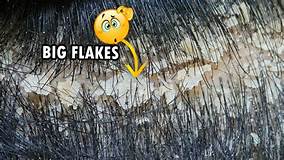
Such conditions can include diabetes, overactive thyroid, arthritis, or seborrhea. If the cat has any of these, the vet can suggest a treatment program.
Cat Dandruff Has A Variety Of Causes
One cause could come from something called a “skin mite,” or Cheyletiella yasguri. The mite feeds on these skin cells, which causes more scale to develop. The mite itself even looks like more of the dandruff, earning it the nickname of “walking dandruff.”
The vet puts samples of the dandruff onto a microscope, and can identify if the cat has skin mites. If so, kitty will be treated with a product containing fipronil. Given every other night for at least 3 times, it will kill the skin mites and take care of the issue.
Some physical problems that can make the dandruff worse: obesity, arthritis, and sore teeth. Obesity or arthritis can make it difficult for the cat to groom all parts of the body. If the cat has some mobility problems, you should groom him daily until he can do it himself.
If kitty has a sore mouth, he could stop grooming, and he may also have trouble eating. Then you must see the vet so he can extract any loose teeth, clean away tartar, and give antibiotics to guard against gum infection.
Another cause of dandruff can be hot, dry weather. Such conditions can lead to dried-out skin or even sunburn. It’s best to keep kitty indoors under very hot weather conditions.
How Can You Help?
If you have a humidifier, consider it a good idea to use it when the weather becomes very hot and dry. Even in winter, if the air gets very dry, you can use the humidifier to good effect.
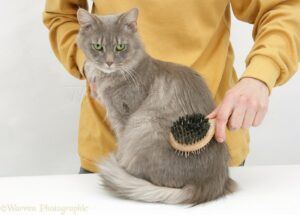 Brush your cat regularly, as this will help remove dead skin flakes, thereby reducing dandruff. Remember to brush gently, always in the direction the hair lies. Don’t use a lot of pressure, and do not brush against the direction the hair grows.
Brush your cat regularly, as this will help remove dead skin flakes, thereby reducing dandruff. Remember to brush gently, always in the direction the hair lies. Don’t use a lot of pressure, and do not brush against the direction the hair grows.
One reason for frequent brushing: It will improve blood circulation to the skin, carrying oxygen and nutrients, which help condition kitty’s skin.
You might think bathing would help the cat, but avoid bathing very often. Bathing too often can strip essential oils from the skin. Then it will become dried-out and flaky, and the dandruff will get worse.
Unless the cat’s coat appears visibly dirty, oily, or matted, you do not need to bathe him. If you do bathe him, use a moisturizing shampoo. One good choice of shampoo will include oatmeal as an ingredient. Do not use human shampoo, as these harsh products will strip out natural oils.
Did you know you can get a moisturizing lotion or a topical ointment designed to help your cat’s dry skin? If your local pet store does not carry such an item, your vet might have a recommendation. You can also order online.
Does your cat’s food contain the essential fatty acids needed to keep skin healthy? If his food does not contain linoleic acid and arachidonic acid, you have a problem, because these are essential for the cat and cannot be made in his body.
If the food lists a named meat as an ingredient, that’s good. Also, do you store it appropriately and away from the extreme temperatures? If not, these factors could degrade those vital fatty acids.
For additional skin conditioning, consider supplementing kitty’s diet with omega fatty acids. Add these to the food. A balanced source of Omega 3 and 6 from fish and marine oils represents the ideal.
Advised dose: Add 75 mg/kg a day. Add to the food.
Make sure your cat has clean water at all times. Change the bowl frequently to keep it fresh. Wash the bowl regularly to kill any bacteria.
Here you will find a list of the causes of cat dandruff: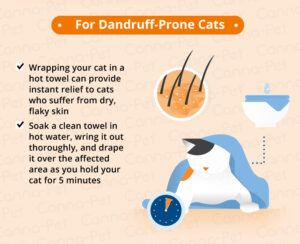
1) Diet: Poor diet causes nutritional deficits, which can lead to skin problems.
2) Hydration: Heat, dry weather, or lack of water can lead to dandruff. If your cat eats wet food, he will get more water than from dry food. To increase the water, just add a little to the food and stir in well.
3) Parasites: These could include fleas, worms, or mites. Sometimes bites from such parasites trigger allergic reactions on kitty’s skin, causing dandruff or excessive itching.
4) Health: Perhaps the dandruff is a symptom of feline diabetes. If you see other diabetic symptoms besides flaky skin, see your vet.
5) Allergies: These can cause dandruff, from such factors as food and environment. Perhaps you have changed the regular routine or you have moved. These can upset the cat’s immune system.
Here you will find options for treatment:
1) If dehydration becomes kitty’s problem, try a cat water fountain. Such a device aerates the water, making drinking more appealing.
2) If you suspect a nutrient deficiency, read the pet food’s label to make sure it contains all the necessary ingredients.
3) If your cat has an environmental allergy, the vet may prescribe an antihistamine or a steroid.
4) Avoid any sudden changes in routine in the home if at all possible. If kitty stays calm and reassured, it could help clear up the problem.
Very often — in fact, usually, cat dandruff will not become a serious condition. If you have found that the vet has ruled out a more serious condition, you can look for natural remedies for the treatment.
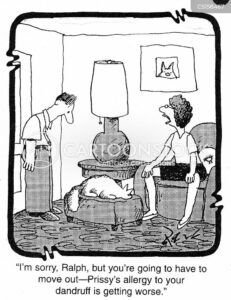 Remember — if kitty does not respond to the treatment, don’t stress. As long as your cat does not scratch or seem uncomfortable, you need not become concerned about the dandruff.
Remember — if kitty does not respond to the treatment, don’t stress. As long as your cat does not scratch or seem uncomfortable, you need not become concerned about the dandruff.
Do you have a humidifier? If not, you might purchase one, as it will provide the necessary moisture in the air. It can help you humans who have dry skin or allergies as well. You won’t need an expensive one — just a small one for the place where you and kitty spend the most time.
What about supplements? Fish oil supplements help skin, coat, and joints. If you feed your cat dry food, these supplements, high in Omega-3 fatty acids, prove of value.
In liquid form, you can add a small amount of the liquid on your cat’s regular food.
Make sure you feed a high-quality cat food. If you worry about a new food causing frequent vomiting or other stomach issues, try mixing a small amount of the new food in with kitty’s old food; then increase the ration daily until the switch becomes complete.
Water intake often needs to be increased. The water fountain can help, or mixing a little extra water into wet food.
You can bathe your cat with a hypoallergenic pet shampoo. Don’t even try bathing if it creates unnecessary stress for kitty. Get a good cat brush, often a better alternative to bathing kitty, as your cat may end up quite relaxed. Stimulating blood flow and removing loose fur and dirt are both beneficial.
Remember, if nothing works, as long as the vet has given kitty a clean bill of health, then don’t worry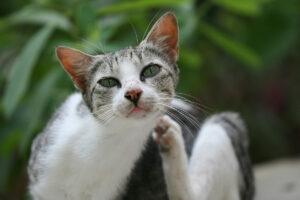 about it. If it doesn’t seem to bother the cat, then don’t let it bother you.
about it. If it doesn’t seem to bother the cat, then don’t let it bother you.
Below you will find a few products you might try to reduce dandruff. Check with your vet to make sure he believes these are good options to try.https://amzn.to/2UQeTvr
Check out the products below:
Removes loose undercoat; pet massage
Price: $10.97
Prime
Zesty Paws pure wild Alaska salmon oil
Supports joint function, immune & heart health
Price: $14.97
Prime
Mad About Organics Oatmeal Shampoo
Formulated for Cats and Small Animals
Price: $7.99
Prime
Cat Water Fountain Stainless Steel, 84 oz/2.5 L
Automatic Pet Water Fountain
Price: $26.99
Prime
Here are the references I used for this post:
https://purina.com/articles/cat/health/cat-dandruff
https://wikihow.com/Get-Rid-Of-Cat-Dandruff
https://petcarerx.com/article/cat-dandruff-remedies-and-solutions/1155
https://felineanswers.com/home-remedies-for-cat-dandruff





